oil filter TOYOTA CAMRY 2000 Service User Guide
[x] Cancel search | Manufacturer: TOYOTA, Model Year: 2000, Model line: CAMRY, Model: TOYOTA CAMRY 2000Pages: 4770, PDF Size: 86.41 MB
Page 297 of 4770
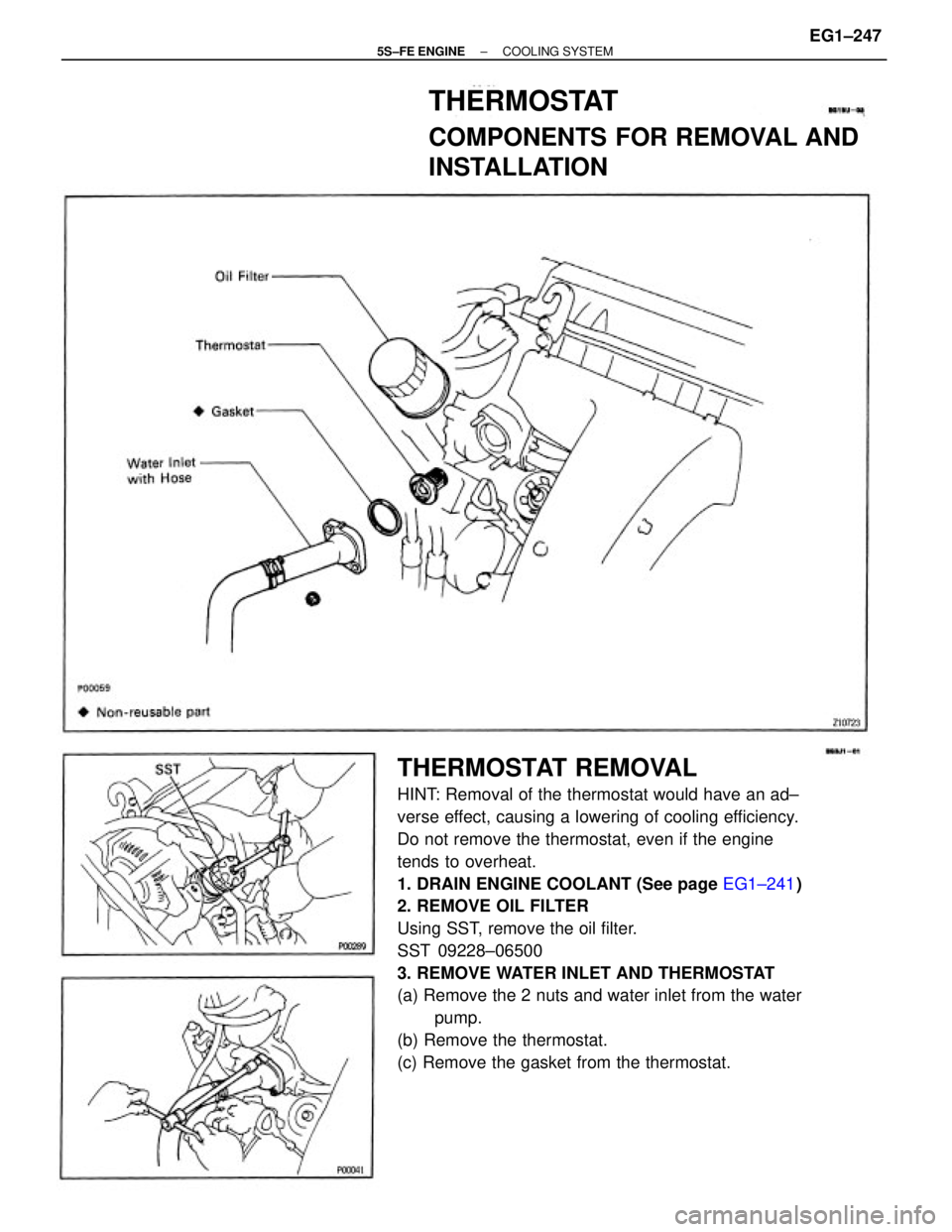
THERMOSTAT REMOVAL
HINT: Removal of the thermostat would have an ad±
verse effect, causing a lowering of cooling efficiency.
Do not remove the thermostat, even if the engine
tends to overheat.
1. DRAIN ENGINE COOLANT (See page EG1±241)
2. REMOVE OIL FILTER
Using SST, remove the oil filter.
SST 09228±06500
3. REMOVE WATER INLET AND THERMOSTAT
(a) Remove the 2 nuts and water inlet from the water
pump.
(b) Remove the thermostat.
(c) Remove the gasket from the thermostat.
THERMOSTAT
COMPONENTS FOR REMOVAL AND
INSTALLATION
± 5S±FE ENGINECOOLING SYSTEMEG1±247
Page 299 of 4770
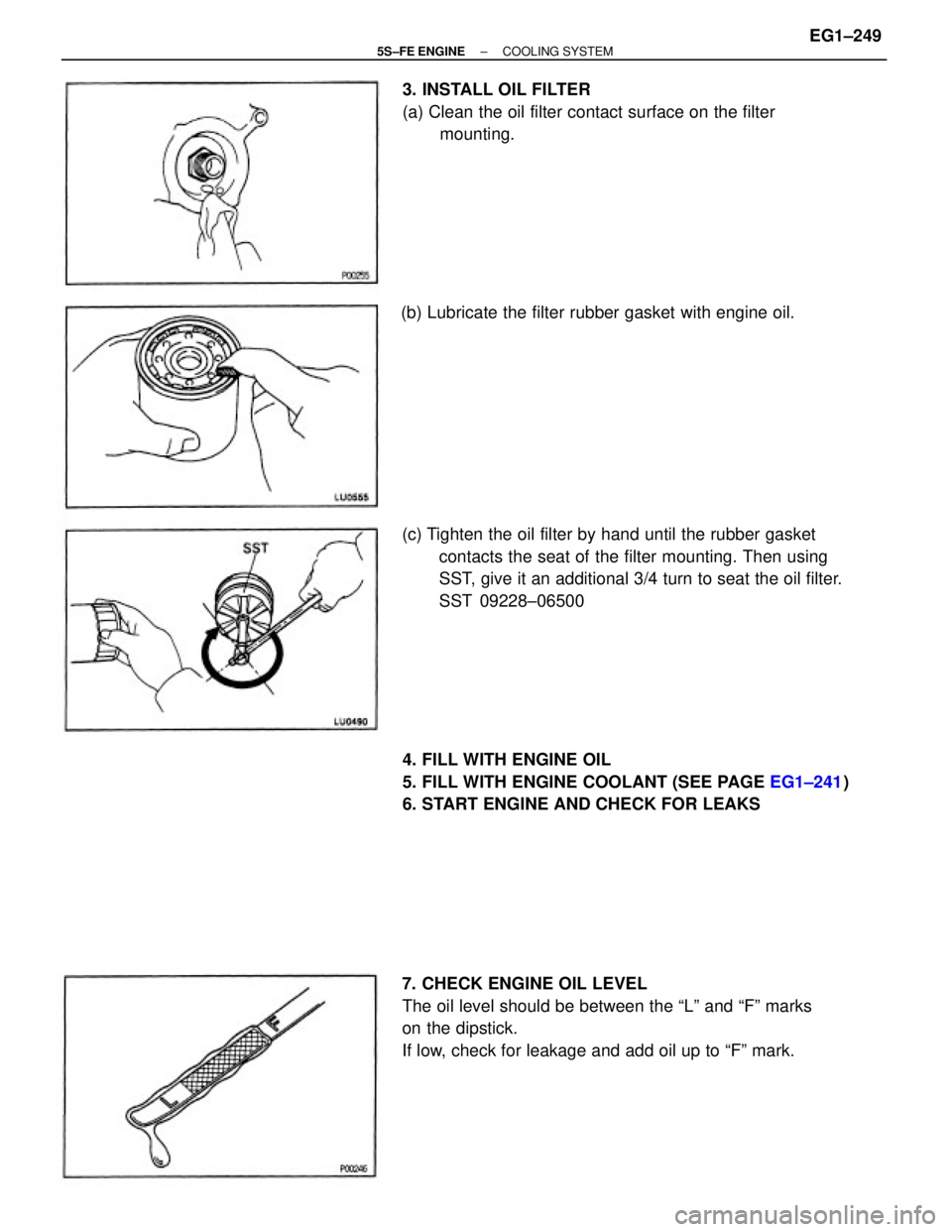
7. CHECK ENGINE OIL LEVEL
The oil level should be between the ªLº and ªFº marks
on the dipstick.
If low, check for leakage and add oil up to ªFº mark. (c) Tighten the oil filter by hand until the rubber gasket
contacts the seat of the filter mounting. Then using
SST, give it an additional 3/4 turn to seat the oil filter.
SST 09228±06500
4. FILL WITH ENGINE OIL
5. FILL WITH ENGINE COOLANT (SEE PAGE EG1±241)
6. START ENGINE AND CHECK FOR LEAKS 3. INSTALL OIL FILTER
(a) Clean the oil filter contact surface on the filter
mounting.
(b) Lubricate the filter rubber gasket with engine oil.
± 5S±FE ENGINECOOLING SYSTEMEG1±249
Page 319 of 4770
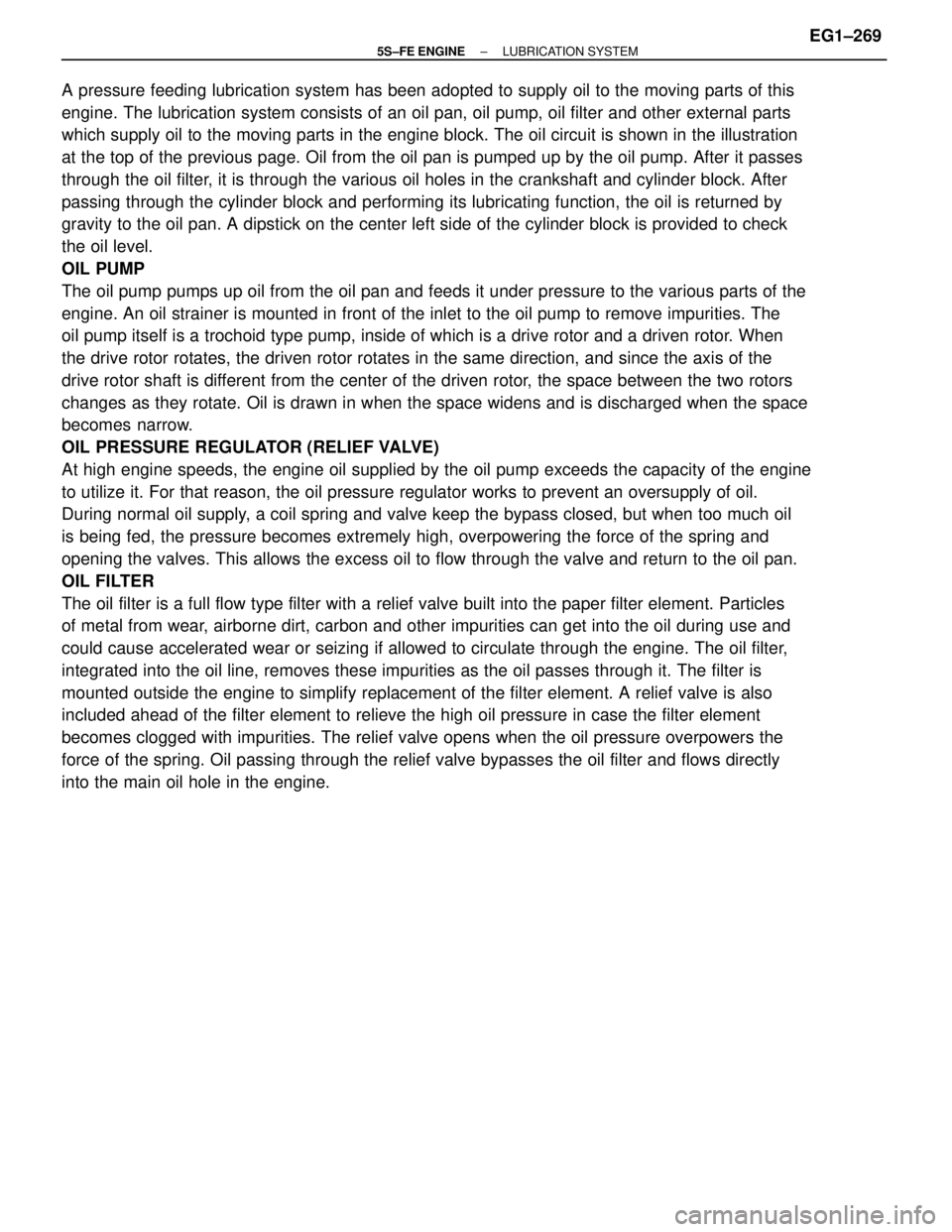
A pressure feeding lubrication system has been adopted to supply oil to the moving parts of this
engine. The lubrication system consists of an oil pan, oil pump, oil filter and other external parts
which supply oil to the moving parts in the engine block. The oil circuit is shown in the illustration
at the top of the previous page. Oil from the oil pan is pumped up by the oil pump. After it passes
through the oil filter, it is through the various oil holes in the crankshaft and cylinder block. After
passing through the cylinder block and performing its lubricating function, the oil is returned by
gravity to the oil pan. A dipstick on the center left side of the cylinder block is provided to check
the oil level.
OIL PUMP
The oil pump pumps up oil from the oil pan and feeds it under pressure to the various parts of the
engine. An oil strainer is mounted in front of the inlet to the oil pump to remove impurities. The
oil pump itself is a trochoid type pump, inside of which is a drive rotor and a driven rotor. When
the drive rotor rotates, the driven rotor rotates in the same direction, and since the axis of the
drive rotor shaft is different from the center of the driven rotor, the space between the two rotors
changes as they rotate. Oil is drawn in when the space widens and is discharged when the space
becomes narrow.
OIL PRESSURE REGULATOR (RELIEF VALVE)
At high engine speeds, the engine oil supplied by the oil pump exceeds the capacity of the engine
to utilize it. For that reason, the oil pressure regulator works to prevent an oversupply of oil.
During normal oil supply, a coil spring and valve keep the bypass closed, but when too much oil
is being fed, the pressure becomes extremely high, overpowering the force of the spring and
opening the valves. This allows the excess oil to flow through the valve and return to the oil pan.
OIL FILTER
The oil filter is a full flow type filter with a relief valve built into the paper filter element. Particles
of metal from wear, airborne dirt, carbon and other impurities can get into the oil during use and
could cause accelerated wear or seizing if allowed to circulate through the engine. The oil filter,
integrated into the oil line, removes these impurities as the oil passes through it. The filter is
mounted outside the engine to simplify replacement of the filter element. A relief valve is also
included ahead of the filter element to relieve the high oil pressure in case the filter element
becomes clogged with impurities. The relief valve opens when the oil pressure overpowers the
force of the spring. Oil passing through the relief valve bypasses the oil filter and flows directly
into the main oil hole in the engine.
± 5S±FE ENGINELUBRICATION SYSTEMEG1±269
Page 320 of 4770
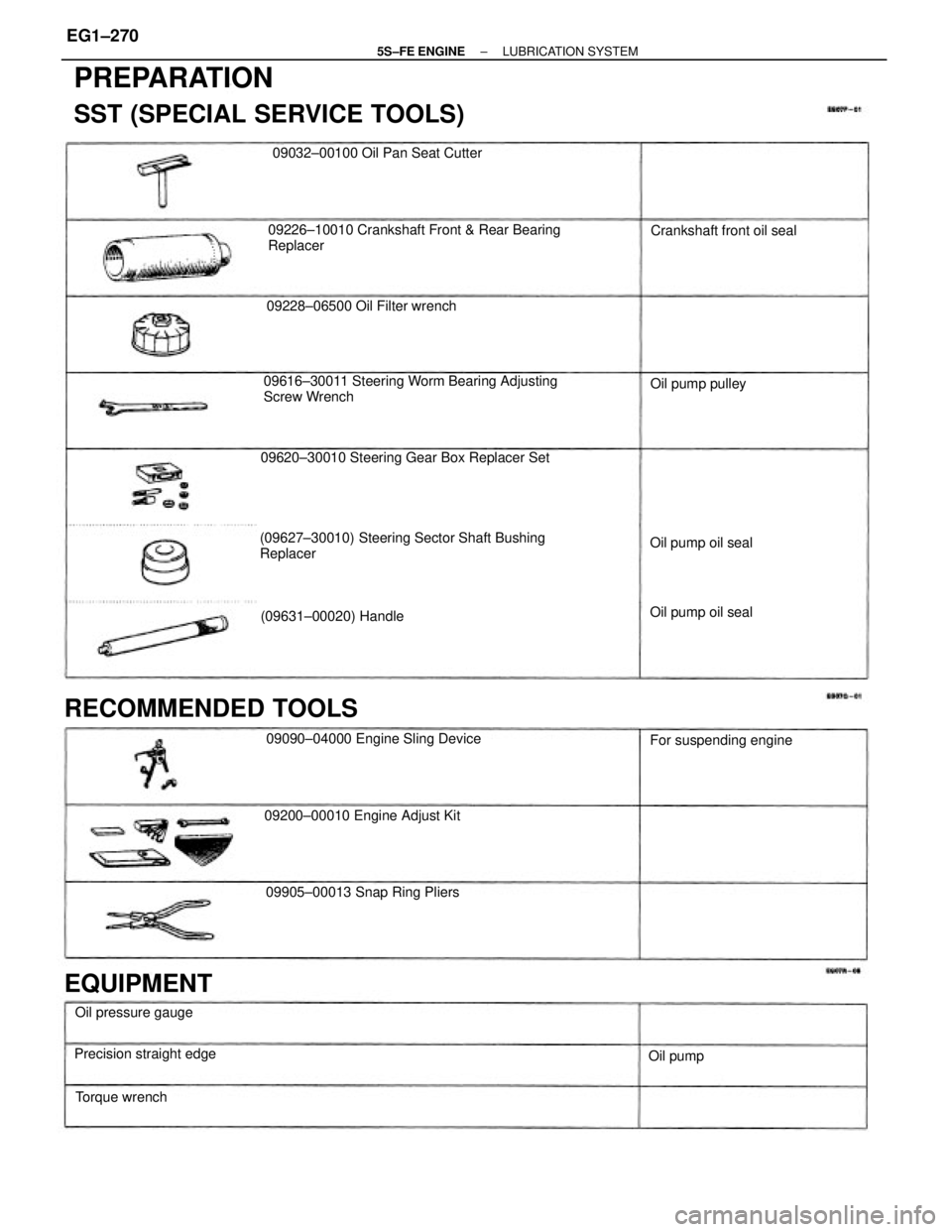
PREPARATION
SST (SPECIAL SERVICE TOOLS)
(09627±30010) Steering Sector Shaft Bushing
Replacer09226±10010 Crankshaft Front & Rear Bearing
Replacer
(09631±00020) Handle09616±30011 Steering Worm Bearing Adjusting
Screw Wrench
RECOMMENDED TOOLS
Oil pump oil seal
Oil pump oil seal 09620±30010 Steering Gear Box Replacer Set
09090±04000 Engine Sling Device
09200±00010 Engine Adjust Kit09032±00100 Oil Pan Seat Cutter
09905±00013 Snap Ring Pliers09228±06500 Oil Filter wrench
Precision straight edge
EQUIPMENT
Oil pressure gaugeFor suspending engineCrankshaft front oil seal
Torque wrenchOil pump pulley
Oil pump
± 5S±FE ENGINELUBRICATION SYSTEMEG1±270
Page 321 of 4770
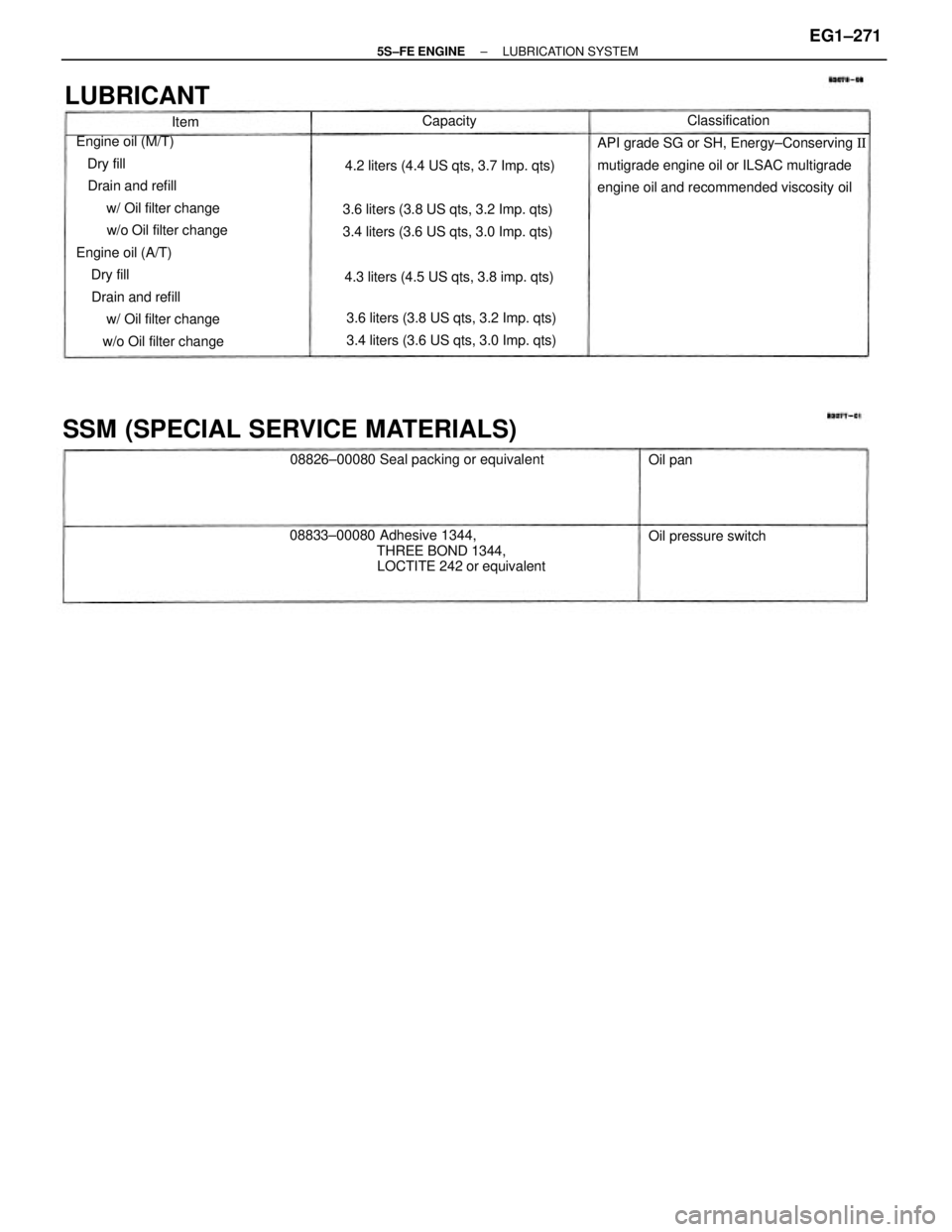
Engine oil (M/T)
Dry fill
Drain and refill
w/ Oil filter change
w/o Oil filter change
Engine oil (A/T)
Dry fill
Drain and refill
w/ Oil filter change
w/o Oil filter changeAPI grade SG or SH, Energy±Conserving II
mutigrade engine oil or ILSAC multigrade
engine oil and recommended viscosity oil
08833±00080 Adhesive 1344,
THREE BOND 1344,
LOCTITE 242 or equivalent
SSM (SPECIAL SERVICE MATERIALS)
3.6 liters (3.8 US qts, 3.2 Imp. qts)
3.4 liters (3.6 US qts, 3.0 Imp. qts)
08826±00080 Seal packing or equivalent4.2 liters (4.4 US qts, 3.7 Imp. qts)
4.3 liters (4.5 US qts, 3.8 imp. qts)
LUBRICANT
Oil pressure switch Oil panClassification
Capacity
Item
3.6 liters (3.8 US qts, 3.2 Imp. qts)
3.4 liters (3.6 US qts, 3.0 Imp. qts)
± 5S±FE ENGINELUBRICATION SYSTEMEG1±271
Page 324 of 4770
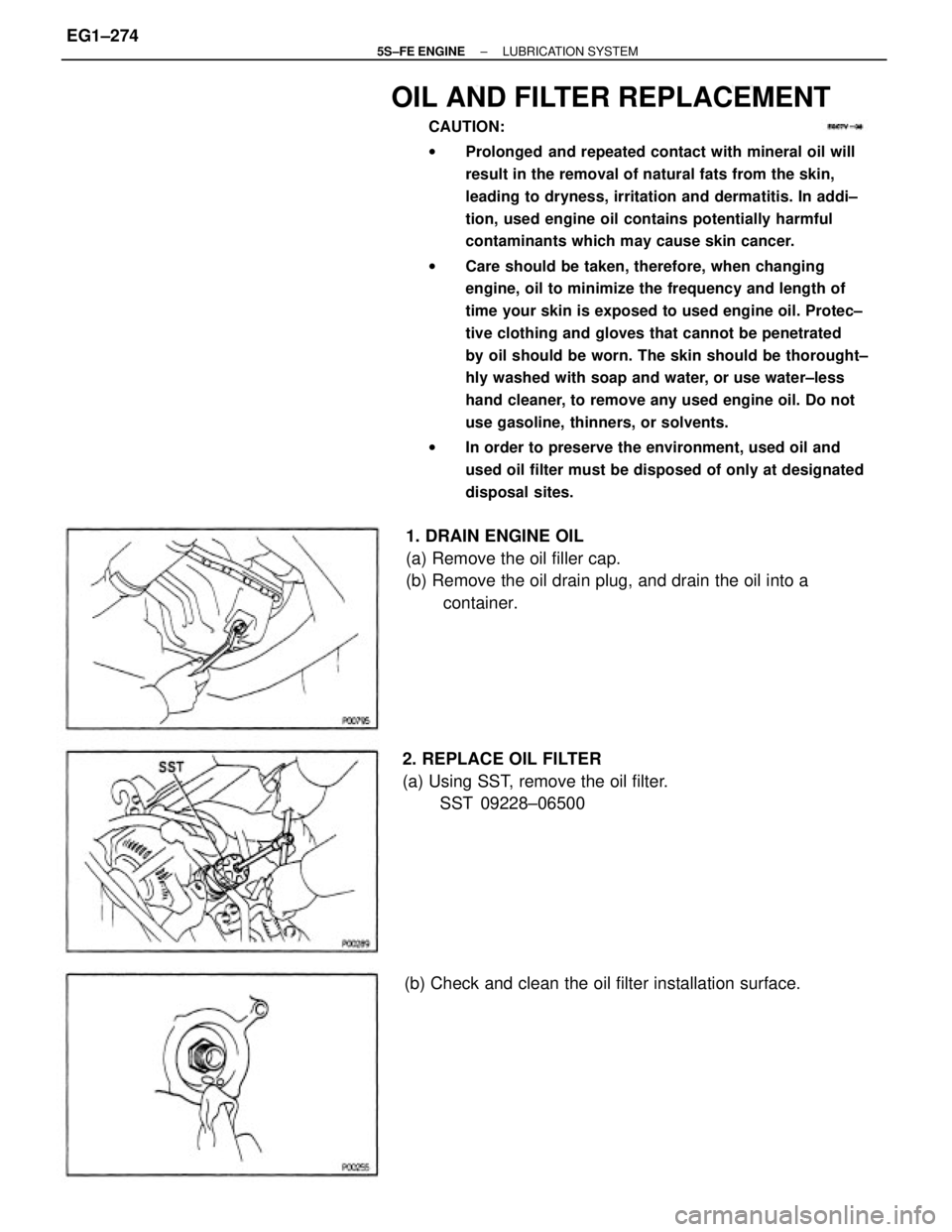
OIL AND FILTER REPLACEMENT
CAUTION:
wProlonged and repeated contact with mineral oil will
result in the removal of natural fats from the skin,
leading to dryness, irritation and dermatitis. In addi±
tion, used engine oil contains potentially harmful
contaminants which may cause skin cancer.
wCare should be taken, therefore, when changing
engine, oil to minimize the frequency and length of
time your skin is exposed to used engine oil. Protec±
tive clothing and gloves that cannot be penetrated
by oil should be worn. The skin should be thorought±
hly washed with soap and water, or use water±less
hand cleaner, to remove any used engine oil. Do not
use gasoline, thinners, or solvents.
wIn order to preserve the environment, used oil and
used oil filter must be disposed of only at designated
disposal sites.
1. DRAIN ENGINE OIL
(a) Remove the oil filler cap.
(b) Remove the oil drain plug, and drain the oil into a
container.
2. REPLACE OIL FILTER
(a) Using SST, remove the oil filter.
SST 09228±06500
(b) Check and clean the oil filter installation surface.
± 5S±FE ENGINELUBRICATION SYSTEMEG1±274
Page 325 of 4770
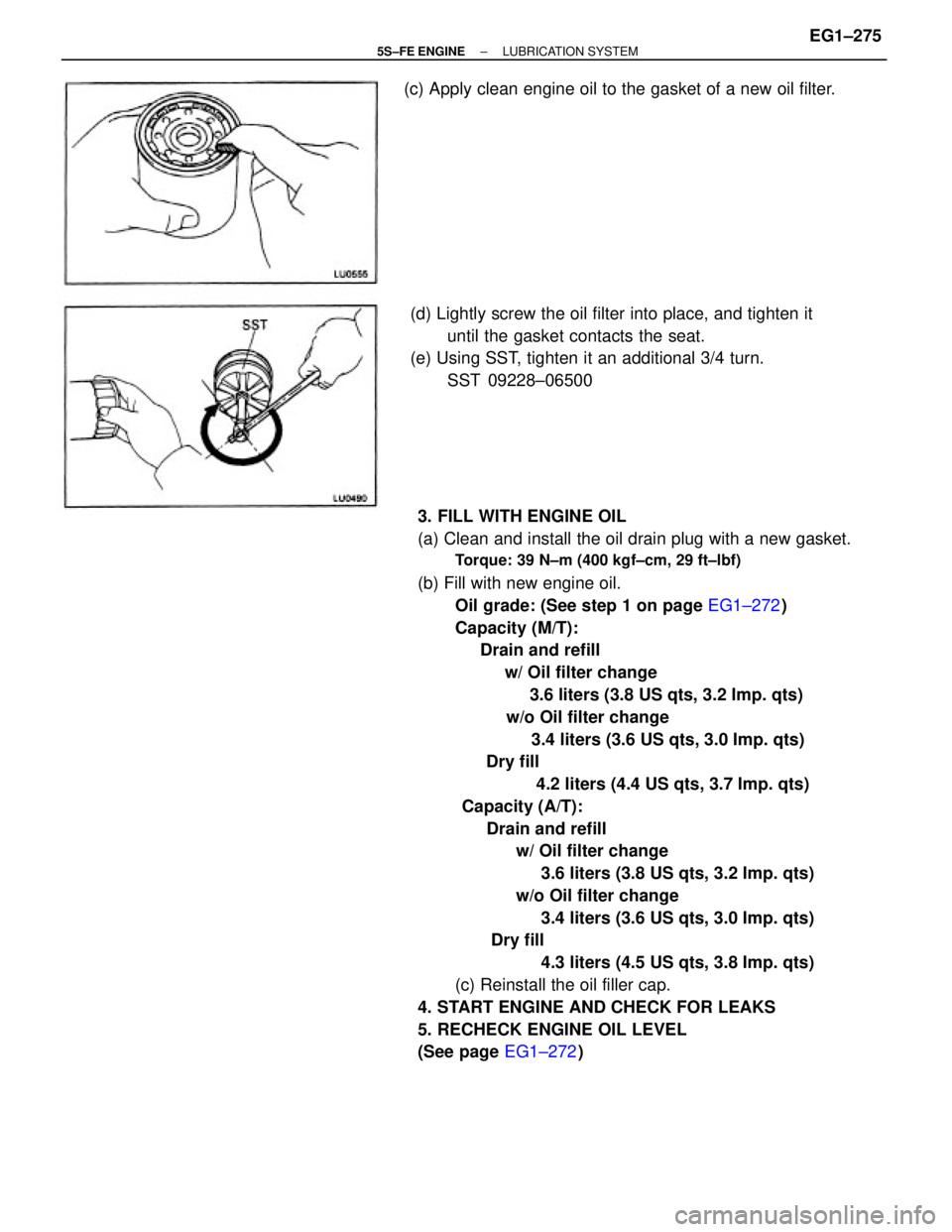
3. FILL WITH ENGINE OIL
(a) Clean and install the oil drain plug with a new gasket.
Torque: 39 N±m (400 kgf±cm, 29 ft±lbf)
(b) Fill with new engine oil.
Oil grade: (See step 1 on page EG1±272)
Capacity (M/T):
Drain and refill
w/ Oil filter change
3.6 liters (3.8 US qts, 3.2 Imp. qts)
w/o Oil filter change
3.4 liters (3.6 US qts, 3.0 Imp. qts)
Dry fill
4.2 liters (4.4 US qts, 3.7 Imp. qts)
Capacity (A/T):
Drain and refill
w/ Oil filter change
3.6 liters (3.8 US qts, 3.2 Imp. qts)
w/o Oil filter change
3.4 liters (3.6 US qts, 3.0 Imp. qts)
Dry fill
4.3 liters (4.5 US qts, 3.8 Imp. qts)
(c) Reinstall the oil filler cap.
4. START ENGINE AND CHECK FOR LEAKS
5. RECHECK ENGINE OIL LEVEL
(See page EG1±272) (d) Lightly screw the oil filter into place, and tighten it
until the gasket contacts the seat.
(e) Using SST, tighten it an additional 3/4 turn.
SST 09228±06500 (c) Apply clean engine oil to the gasket of a new oil filter.
± 5S±FE ENGINELUBRICATION SYSTEMEG1±275
Page 336 of 4770
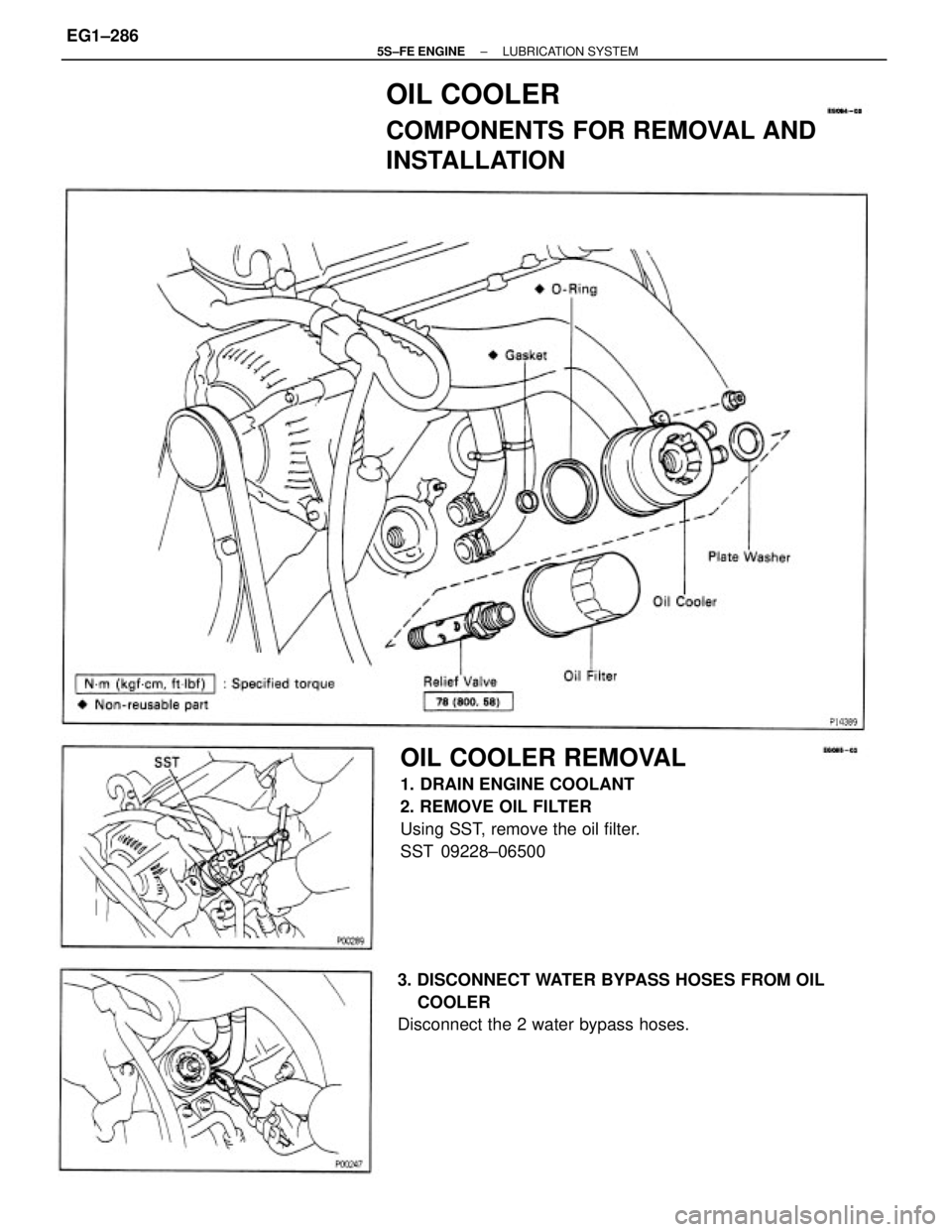
OIL COOLER REMOVAL
1. DRAIN ENGINE COOLANT
2. REMOVE OIL FILTER
Using SST, remove the oil filter.
SST 09228±06500
3. DISCONNECT WATER BYPASS HOSES FROM OIL
COOLER
Disconnect the 2 water bypass hoses.
OIL COOLER
COMPONENTS FOR REMOVAL AND
INSTALLATION
± 5S±FE ENGINELUBRICATION SYSTEMEG1±286
Page 338 of 4770
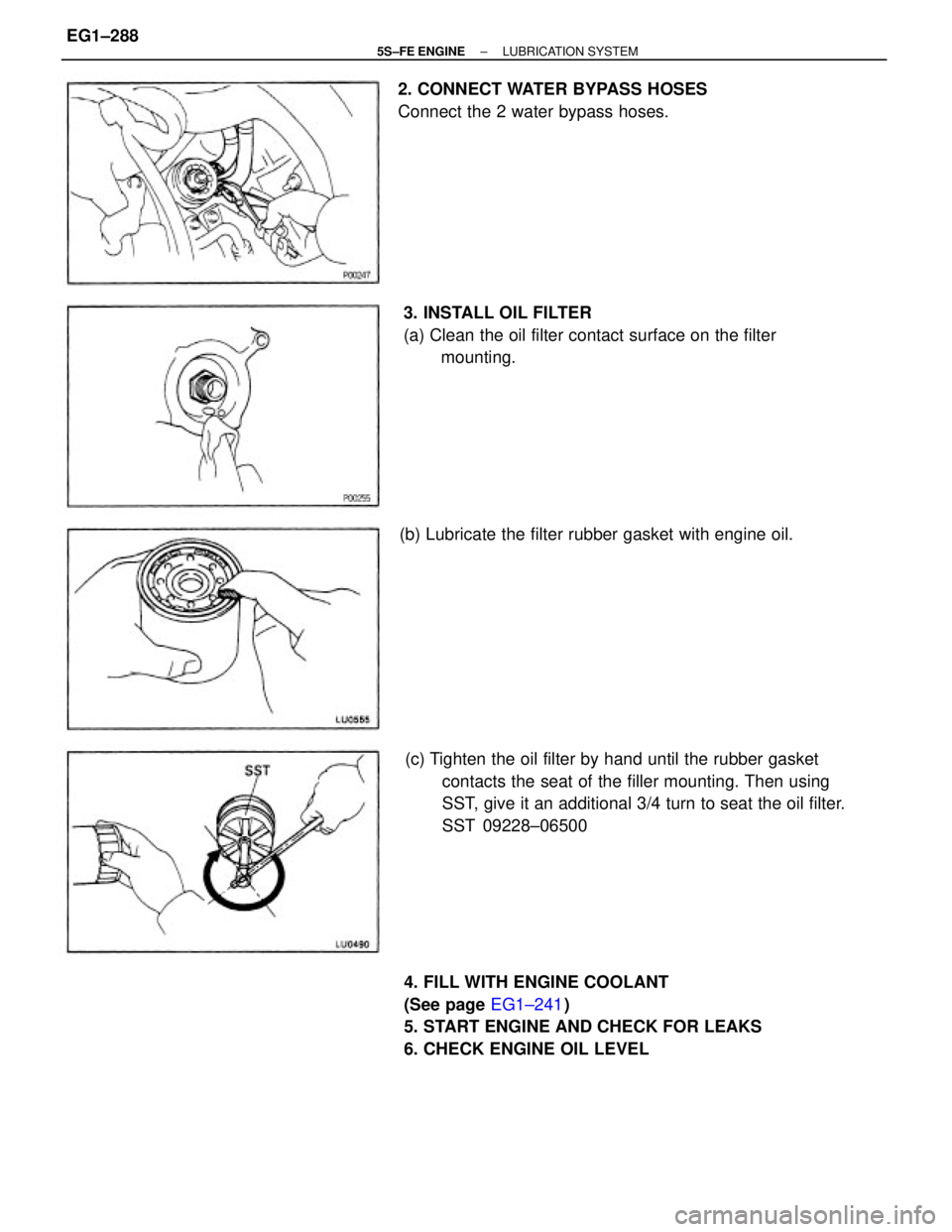
(c) Tighten the oil filter by hand until the rubber gasket
contacts the seat of the filler mounting. Then using
SST, give it an additional 3/4 turn to seat the oil filter.
SST 09228±06500
4. FILL WITH ENGINE COOLANT
(See page EG1±241)
5. START ENGINE AND CHECK FOR LEAKS
6. CHECK ENGINE OIL LEVEL 3. INSTALL OIL FILTER
(a) Clean the oil filter contact surface on the filter
mounting. 2. CONNECT WATER BYPASS HOSES
Connect the 2 water bypass hoses.
(b) Lubricate the filter rubber gasket with engine oil.
± 5S±FE ENGINELUBRICATION SYSTEMEG1±288
Page 360 of 4770
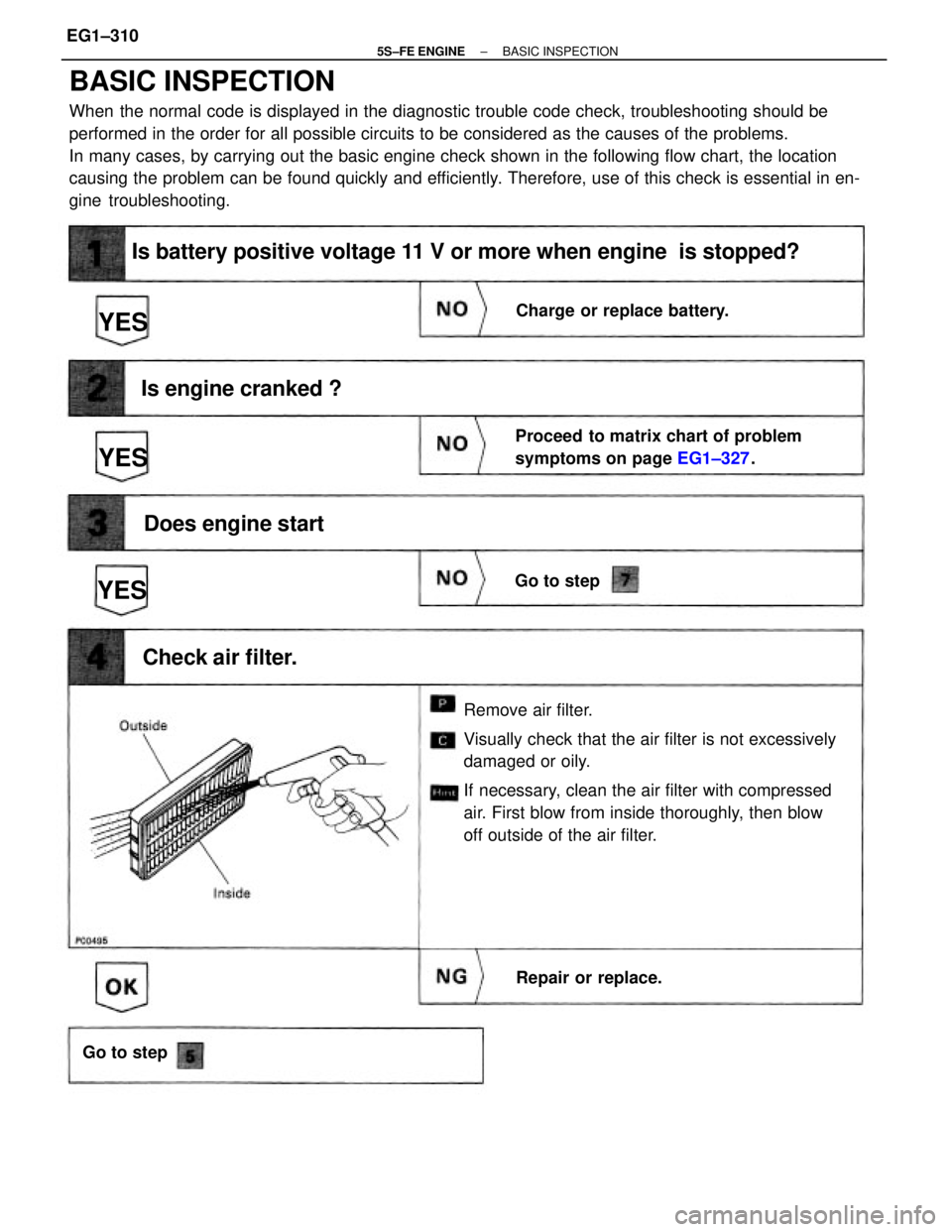
BASIC INSPECTION
When the normal code is displayed in the diagnostic trouble code check, troubleshooting should be
performed in the order for all possible circuits to be considered as the causes of the problems.
In many cases, by carrying out the basic engine check shown in the following flow chart, the location
causing the problem can be found quickly and efficiently. Therefore, use of this check is essential in en-
gine troubleshooting.
Remove air filter.
Visually check that the air filter is not excessively
damaged or oily.
If necessary, clean the air filter with compressed
air. First blow from inside thoroughly, then blow
off outside of the air filter.
Is battery positive voltage 11 V or more when engine is stopped?
Proceed to matrix chart of problem
symptoms on page EG1±327.
Is engine cranked ?
Does engine start
Charge or replace battery.
Check air filter.
Repair or replace. Go to step
Go to step
YESYES
YES
± 5S±FE ENGINEBASIC INSPECTIONEG1±310